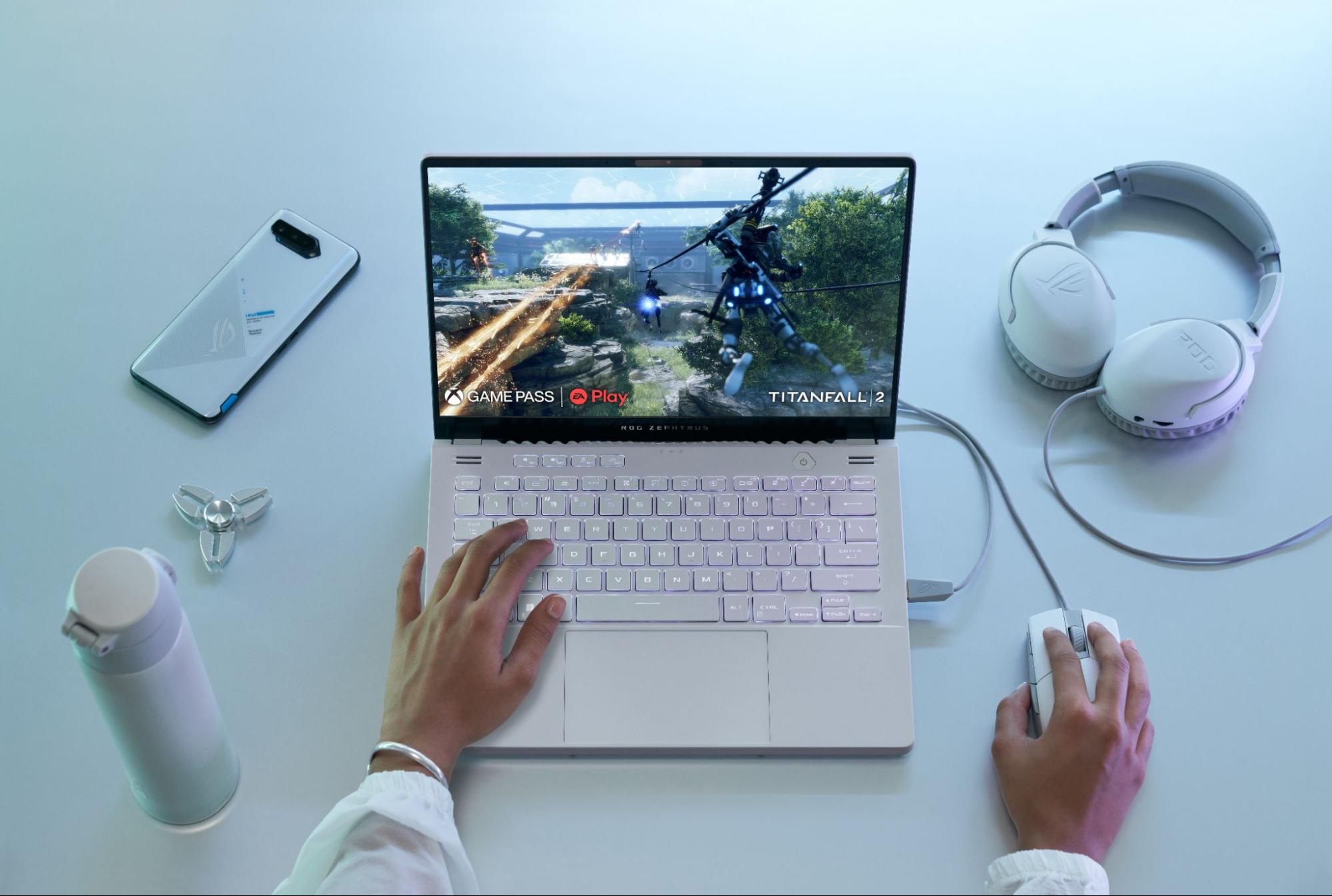Asus’ ROG Flow Z13 Is a Surface-Like Tablet for Gamers
The dual-screen Zephyrus Duo also bulks up to 16 inches, and the G14 gets a webcam and new AMD options.
Asus' 2022 gaming lineup is comprehensive, covering almost its entire existing product stack with updates to the latest from Intel, AMD and Nvidia. But perhaps the most interesting among them is a gaming tablet, the Asus ROG Flow Z13. That comes amid other updates, including a 16-inch ROG Zephyrus Duo and revamps of the TUF line of budget notebooks.
The ROG Flow Z13 is a 13.4-inch tablet that kind of resembles a Surface device for gamers. In fact, it even looks like a slightly more reasonable version of the ROG Mothership from 2019, which also had a detachable keyboard (but was huge and far more powerful for its time).
Asus is using 12th Gen Intel processors in the ROG Flow Z13, ranging from a Core i5 up to an Intel Core i9-12900H with either an RTX 3050 or RTX 3050 Ti on board. But like last year's ROG Flow X13, it can use the XG Mobile dock with up to an RTX 3080 laptop GPU over a proprietary connection for faster gaming. This new graphics dock is slightly bigger and heavier than the original.
| Header Cell - Column 0 | Asus ROG Flow Z13 (GZ301) | Asus Zephyrus Duo 16 (GX650) | Asus ROG Zephyrus G14 (GA402) | Asus ROG Zephyrus G15 (GA503) |
|---|---|---|---|---|
| CPU | Up to Intel Core i9-12900H | Up to AMD Ryzen 9 6900HX | Up to AMD Ryzen 9 6900HS | Up to AMD Ryzen 9 6900HS |
| Graphics | Up to Nvidia GeForce RTX 3050 Ti | Up to Nvidia GeForce RTX 3080 Ti | Up to AMD Radeon RX 6800S | Up to Nvidia GeForce RTX 3080 Ti |
| Display | 13.4-inch, 16:10. UHD at 60 Hz or FHD at 120 Hz | 16-inch, 16:10 with "Nebula HDR" mini LED, QHD 165 Hz, or IPS at either UHD/120 Hz or QHD/165 Hz | 14-inch, 16:10 QHD 120 Hz or FHD 144 Hz | 15-inch, QHD 240 Hz |
| 14.09-inch secondary display, either 1920 x 440 or 3820 x 1100, 60 Hz | ||||
| RAM | Up to 32GB LPDDR5-5200 (soldered) | Up to 64GB DDR5-4800 (slotted) | Up to 32GB DDR5-3800 (up to16GB soldered, one DIMM slot) | Up to 32GB DDR5-3800 (one soldered, one DIMM slot) |
| Storage | Up to 1TB m.2 PCIe 4.0 SSD (m.2 2230) | Up to 2x 2TB PCIe 3.0 SSD with RAID0 | Up to 1TB m.2 PCIe 4.0 SSD | Up to 1TB m.2 PCIe 4.0 SSD |
| Battery | 56 WHr | 90 WHr | 76 WHr | 90 WHr |
| Connectivity | WiFi 6E, Bluetooth | Wi-Fi 6E, Bluetooth | Wi-Fi 6E, Bluetooth | Wi-Fi 6E, Bluetooth |
The tablet itself weighs about 2.42 pounds and is just 12 mm thick. It can be separated from the keyboard cover, which has RGB lighting because how else would you know it's for gaming? Asus claims the cover offers 1.7 millimeters of travel.
Unlike Microsoft, which uses a 3:2 aspect ratio in it's (decidedly non-gaming) tablets, Asus is using 16:10. There will be a 120 Hz pane option, which Asus is saying is "FHD," but is likely higher than the standard 1920 x 1080 due to the extra height. The same goes for the "4K" panel, which will run at 60 Hz. Additionally, there are both front- and rear-facing cameras on this device.
Asus is cooling the tablet with the help of a vapor chamber over both the processor and graphics, as well as liquid metal on the CPU. With the kickstand opened for more airflow, Asus claims that the Flow Z13 can run under 32 decibels, even under intense workloads.
There's a door behind the kickstand for an m.2 2230 SSD, which is similar to what Microsoft has done on the Surface Pro.


If you're looking for something bigger and more powerful, Asus has kicked the ROG Zephyrus Duo up to 16-inches. The dual-screen laptop will use processors up to AMD’s Ryzen 9 6900HX and Nvidia GeForce RTX 3080 Ti, including a MUX switch to ensure you get the performance you expect on the main display. The GPU will offer up to 150W of TGP, with dynamic boost.
That main screen is now 16-inches, and Asus is debuting what it calls "Nebula HDR," with Mini LEDs in 512 zones and 1,200 nits of peak brightness. That's on a QHD display at 165 Hz, though again, the resolution should be slightly higher than 2560 x 1440 due to the 16:10 aspect ratio. The half-height secondary panel goes up to 3820 x 1100 and measures 14.09 inches diagonally.
The new design minimizes the gap between the two displays, making the transition between the two panels appear more seamless, and Asus is promising better viewing angles on that ScreenPad Plus–which is good given that was an issue with previous iterations of the Zephyrus Duo.
The cooling system has been upgraded again, too. The ScreenPad Plus actually slides backwards now, to show off a part of the motherboard (with, of course, RGB lighting for good measure). It has fans that are 0.7 mm higher, which the company claims offers 11% more airflow than the previous Zephyrus Duo, and the CPU is being cooled with Conductonaut Extreme thermal compound, which Asus says drops temperatures up to 14 degrees Celsius lower than typical thermal grease.
Other features include an IR camera to log in with Windows Hello, a six-speaker audio system (four speakers and two tweeters) and up to 64GB of DDR5 RAM.


For traditionalists, the AMD ROG Zephyrus G14 is getting a refresh with a 16:10 display and, thank heavens, a webcam (and an IR webcam, for Windows Hello). We’re eager to see if the new model will also earn a spot on our best gaming laptops list.
The G14 is still an all-AMD machine with up to AMD Ryzen 9 6900HS CPU and Radeon RX 6800S GPU (Asus is claiming up to 105W of GPU power with AMD's SmartShift technology). Both the CPU and GPU will be cooled with liquid metal and a vapor chamber.
But the G14 has been redesigned on the outside, too: The display has 50% slimmer bezels on the sides and bottom, and the touchpad is twice as big as the previous model.
And yes, the Anime Matrix display on the lid is back, now with smaller perforations, more holes, higher brightness and better contrast. Asus is also adding minigames that you play on the lid using a mouse, though I would imagine the games you play on the real screen will be far more interesting.
The G15 is seeing less of a shift. It's getting a bump to the Ryzen 9 6900HS and RTX 3080 Ti, and it too will now have a webcam. But it's maintaining a 16:19 display.
Other laptops being updated to the latest silicon include the Asus ROG Strix G15 and G17, the Strix Scar 15 and 17, Asus TUF Dash 15 and the TUF Gaming A15, A17, F15 and F17.
Pricing and availability were not immediately made available.
Get Tom's Hardware's best news and in-depth reviews, straight to your inbox.

Andrew E. Freedman is a senior editor at Tom's Hardware focusing on laptops, desktops and gaming. He also keeps up with the latest news. A lover of all things gaming and tech, his previous work has shown up in Tom's Guide, Laptop Mag, Kotaku, PCMag and Complex, among others. Follow him on Threads @FreedmanAE and BlueSky @andrewfreedman.net. You can send him tips on Signal: andrewfreedman.01